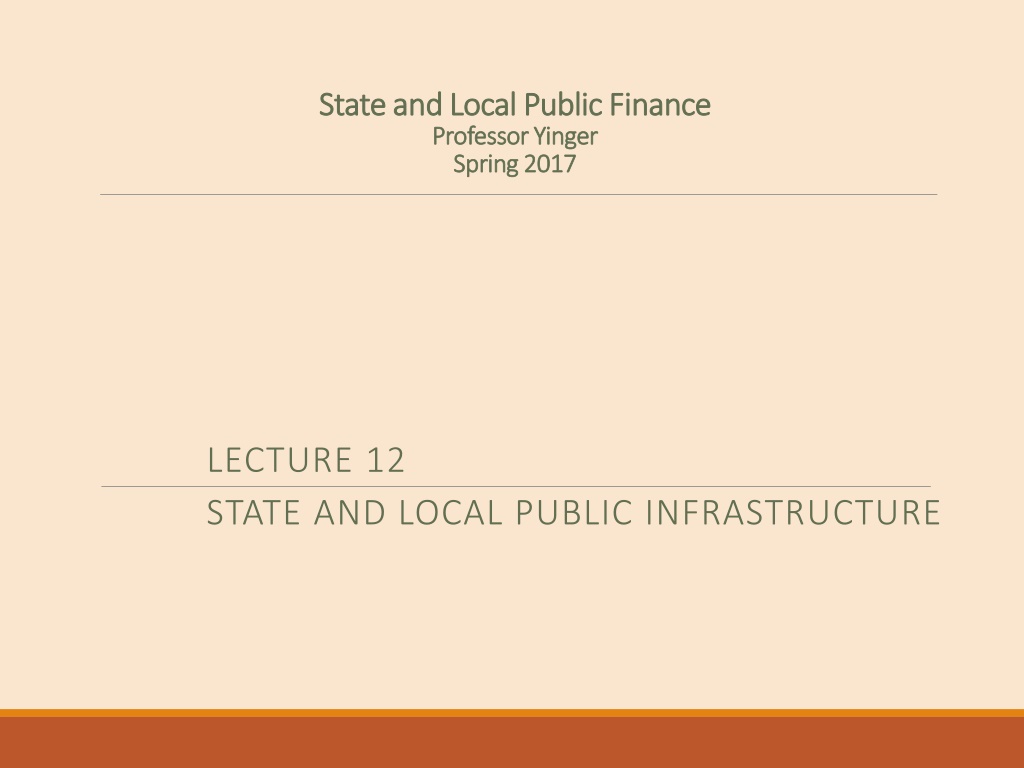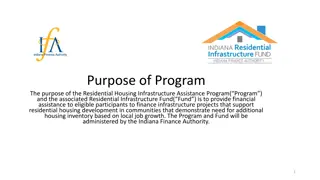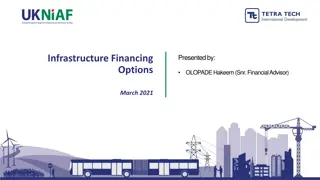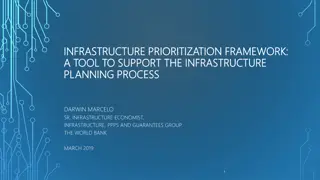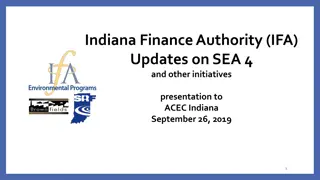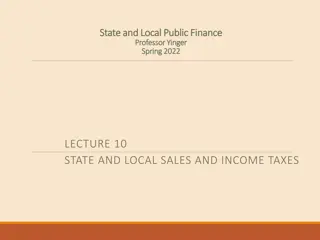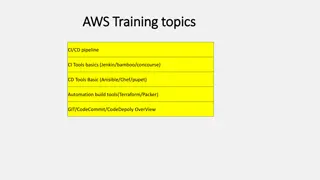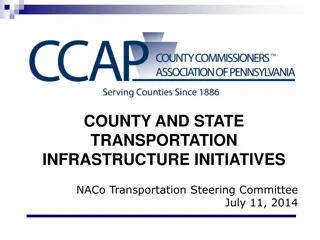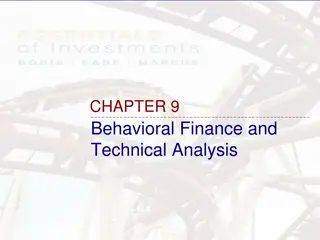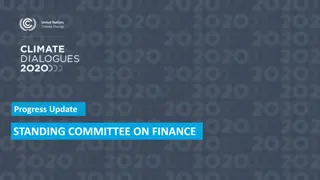Understanding State and Local Public Infrastructure Finance
Exploring the significance of state and local public infrastructure finance, this lecture discusses the need for investment in long-lived public assets like roads, bridges, water systems, and energy production. It highlights the urgency to address the deteriorating infrastructure in the US and the importance of making informed decisions on infrastructure projects amidst the pressing need for significant investments. The lecture emphasizes the potential benefits of investing in infrastructure, such as providing stimulus and taking advantage of low borrowing costs, while addressing the challenges and risks associated with infrastructure development.
- Infrastructure Finance
- Public Investment
- State and Local Government
- Capital Spending
- Infrastructure Needs
Download Presentation

Please find below an Image/Link to download the presentation.
The content on the website is provided AS IS for your information and personal use only. It may not be sold, licensed, or shared on other websites without obtaining consent from the author. Download presentation by click this link. If you encounter any issues during the download, it is possible that the publisher has removed the file from their server.
E N D
Presentation Transcript
State and Local Public Finance State and Local Public Finance Professor Yinger Professor Yinger Spring Spring 2017 2017 LECTURE 12 STATE AND LOCAL PUBLIC INFRASTRUCTURE
State and Local Public Finance State and Local Public Finance Lecture 12: State and Local Lecture 12: State and Local P Public Infrastructure ublic Infrastructure Class Outline What Is Known about Capital Spending? How to Make Decisions about Infrastructure Projects Paying for Infrastructure
State and Local Public Finance State and Local Public Finance Lecture 12: State and Local Lecture 12: State and Local P Public Infrastructure ublic Infrastructure What Is Infrastructure? Infrastructure is long-lived public investment: o Roads, bridges, transit o Dams, drinking water systems o Wastewater systems o Hazardous waste disposal sites o Navigable waterways, railroads o Energy production systems o Parks and recreation ASCE (civil engineers) estimates that the U.S. needs $3.6 trillion investment in infrastructure over the next 5 years. It is a great time to invest in infrastructure: o It provides badly needed stimulus. o Borrowing costs are very low.
State and Local Public Finance State and Local Public Finance Lecture 12: State and Local Lecture 12: State and Local P Public Infrastructure ublic Infrastructure
State and Local Public Finance State and Local Public Finance Lecture 12: State and Local Lecture 12: State and Local P Public Infrastructure ublic Infrastructure Infrastructure Needs Recent years have seen numerous examples of danger from deteriorating bridges, poorly maintained rail lines, and outdated water systems. These issues led to the formation of the Building America s Future Education Fund (BAFuture) to try to boost awareness of infrastructure needs. See: http://bafuture.org/
State and Local Public Finance State and Local Public Finance Lecture 12: State and Local Lecture 12: State and Local P Public Infrastructure ublic Infrastructure Infrastructure Needs, 2 One of the Co-Chairs of BAFuture, Ray LaHood, who was Secretary of Transportation, clearly made the main points in a 2016 op-ed in Time Magazine. See: http://time.com/3860397/ray-lahood-amtrak-tragedy-infrastructure/
State and Local Public Finance State and Local Public Finance Lecture 12: State and Local Lecture 12: State and Local P Public Infrastructure ublic Infrastructure Capital Spending Capital spending is difficult to study because of its variability from year to year. Wang/Duncombe/Yinger (National Tax Journal, September 2011) find that school capital spending in New York has many of the same determinants as school operating spending: o Tax price (elasticity = -0.22) o Income (elasticity = 0.2)
State and Local Public Finance State and Local Public Finance Lecture 12: State and Local Lecture 12: State and Local P Public Infrastructure ublic Infrastructure Capital Spending, 2 In New York, school building aid is provided through a matching grant, and most districts are quite responsive to the matching rate. o The estimated elasticity is -0.42. However, this response is about zero (elasticity = -0.023) for high- need districts. o Even strong price incentives cannot boost school capital spending in New York s neediest districts.
State and Local Public Finance State and Local Public Finance Lecture 12: State and Local Lecture 12: State and Local P Public Infrastructure ublic Infrastructure Infrastructure Decisions When should a particular infrastructure project be built? Benefit-cost analysis is well suited to answering this question. Benefit-cost analysis is a set of tools that help to reduce a decision about a complex program to a manageable level.
State and Local Public Finance State and Local Public Finance Lecture 12: State and Local Lecture 12: State and Local P Public Infrastructure ublic Infrastructure Benefit-Cost Analysis Any government project has complex effects across o (1) markets, o (2) time, and o (3) groups. Benefit-cost analysis helps to simplify the analysis of each of these dimensions.
State and Local Public Finance State and Local Public Finance Lecture 12: State and Local Lecture 12: State and Local P Public Infrastructure ublic Infrastructure Benefit-Cost Analysis, 2 To simplify across markets, benefit-cost analysis expresses everything in terms of willingness to pay, often measured with consumer surplus or cost savings. o The value of commuting time saved due to a new highway or subway stop. o The consumer surplus from the new recreation opportunities created by a dam.
State and Local Public Finance State and Local Public Finance Lecture 12: State and Local Lecture 12: State and Local P Public Infrastructure ublic Infrastructure Benefit-Cost Analysis, 3 To simplify across time, benefit-cost analysis expresses everything in terms of present value; that is, it uses discounting. See posted notes. o The best discount rate is a long-term, low-risk rate, such as the rate for long term government bonds. o The discount rate (the denominator) and the benefits and costs (the numerator) should both be either in real or in nominal terms.
State and Local Public Finance State and Local Public Finance Lecture 12: State and Local Lecture 12: State and Local P Public Infrastructure ublic Infrastructure Benefit-Cost Analysis, 4 Consider real/real. The numerator is easy. Benefits and costs in each year are entered in real terms with no inflation adjustment. So a $1,000 benefit today that is expected to continue just stays at $1,000. The denominator is hard. Any observed interest rate is nominal because it recognizes that money will be paid back in the future in dollars that are not worth as much. So to get a real rate, anticipated inflation (not directly observed!) must be subtracted from a market rate.
State and Local Public Finance State and Local Public Finance Lecture 12: State and Local Lecture 12: State and Local P Public Infrastructure ublic Infrastructure Benefit-Cost Analysis, 5 Consider nominal/nominal. o Now the numerator is hard. The $1,000 in the first year must be inflated with an expected inflation rate for later years. o The denominator is easy because market rates are in nominal terms. o Note that real/real and nominal/nominal are equivalent. If the numerator is inflated at rate a percent per year and the project has a long life, then the present value expression collapses to one with real benefits in the numerator and r-a, the real interest rate, in the denominator.
State and Local Public Finance State and Local Public Finance Lecture 12: State and Local Lecture 12: State and Local P Public Infrastructure ublic Infrastructure Benefit-Cost Analysis, 6 Official B/C analysis uses real/real. The Office of Management and Budget requires calculations with a 3% rate and with a 7% rate. A 7% rate is undoubtedly too high. The Council of Economic Advisers defines the real social discount rate as the real the difference between the nominal annual yield on the 10- year note less the five-year unweighted moving average of current and past annual inflation. This rate is below 1%. See: https://www.whitehouse.gov/sites/default/files/page/files/201701_cea _discounting_issue_brief.pdf
State and Local Public Finance State and Local Public Finance Lecture 12: State and Local Lecture 12: State and Local P Public Infrastructure ublic Infrastructure Benefit-Cost Analysis, 7 Third, benefit-cost analysis can highlight impacts on different groups, But it cannot save a decision maker from placing weights on these impacts. Programs designed to help a particular group should give them net benefits. Ignoring inter-group impacts is an implicit value judgment.
State and Local Public Finance State and Local Public Finance Lecture 12: State and Local Lecture 12: State and Local P Public Infrastructure ublic Infrastructure Benefit-Cost Analysis, 8 A final key issue is: transfers. o In my experience, this is the trickiest issue in all of B/C analysis: A transfer arises when a program shifts benefits or costs from one group to another. o Transfers do not represent real resources gained or lost just real resources transferred. Traditional B-C says they should be ignored, but transfers often have important equity consequences, which should be considered.
State and Local Public Finance State and Local Public Finance Lecture 12: State and Local Lecture 12: State and Local P Public Infrastructure ublic Infrastructure Benefit-Cost Analysis, 9 Transfer Example 1: Taxes (or any government revenue). Taxes are never real resources created or lost from the point of view of citizens. They are only resources from the point of view of governments. B/C does not take the point of view of a government it takes the point of view of the people. New taxes may solve the problem of a budget officer, but they take real resources away from the taxpayer and redistribute them, through the public budget, to other taxpayers. We may care about the distributional consequences; if we are trying to help a particular group and all of their benefits are taxed away, it is not a very good program, even if B>C.
State and Local Public Finance State and Local Public Finance Lecture 12: State and Local Lecture 12: State and Local P Public Infrastructure ublic Infrastructure Benefit-Cost Analysis, 10 Transfer Example 2: Property Values Many programs affect property values. o Property values reflect real resources created that become accessible to people who own nearby property. o A park creates real benefits (esthetic and recreational), which are transferred to nearby property owners. o We can measure the benefits by looking at impacts on property values, but we cannot include both property value impacts and the direct measures of underlying CS as benefits. o With direct CS measures, property values only matter if they connect with an equity concern; a park may not help renters, for example, because it leads to higher rents (and values) so the benefits are transferred to property owners.
State and Local Public Finance State and Local Public Finance Lecture 12: State and Local Lecture 12: State and Local P Public Infrastructure ublic Infrastructure Benefit-Cost Analysis, 11 Transfer Example 3: Effects in Related Markets Producing a new good or service often has an effect in a related market. o These effects do not involve the creation of new resources; instead they are just a re-shuffling of existing resources that arises because of opportunities created by the new good. o Suppose a government builds a park. Ice cream cone venders will come to the park and sell ice cream cones; movie theatre owners will lose business. These effects do not involve resources gained or lost just re-shuffling. o It looks like there is an increase in consumer surplus when the ice-cream-cone demand curve shifts out. But in fact, the possibilities for consuming ice cream cones and movies are already built into the demand curve for visits to a park, so they are already taken care of by the consumer surplus calculation for parks.
State and Local Public Finance State and Local Public Finance Lecture 12: State and Local Lecture 12: State and Local P Public Infrastructure ublic Infrastructure Benefit-Cost Analysis, 12 Transfer Example 5: Displacement In general, local projects cannot influence the overall level of employment. If they could, we wouldn t have any unemployment! o A program may, indeed, hire some people, but there is very likely to be an associated loss of jobs somewhere else in the economy. So jobs are just transferred from one person to another. o It is possible that a project results in the hiring of people who would otherwise be unemployed with no displacement. Some analysts would say this applies to a program for the long-term unemployed. o But even here, one must be careful, because the benefits are not as great as one might think. Everyone puts some value on his or her leisure time, so the net benefits from the job equal wages minus lost leisure.
State and Local Public Finance State and Local Public Finance Lecture 12: State and Local Lecture 12: State and Local P Public Infrastructure ublic Infrastructure Benefit-Cost Analysis, 13 Benefit-cost analysis should not be blamed for the complexity of infrastructure decisions. Benefit-cost analysis can simplify a decision, but it cannot make value judgments or eliminate uncertainty. Try to frame benefit-cost analysis to focus on the factors that require analytical or value judgments.
State and Local Public Finance State and Local Public Finance Lecture 12: State and Local Lecture 12: State and Local P Public Infrastructure ublic Infrastructure Paying For Infrastructure Many people think a government can pay for infrastructure through borrowing. This is not true. Borrowing simply spreads the financing burden over time. Taxes or fees are needed to pay for the infrastructure, with or without borrowing.
State and Local Public Finance State and Local Public Finance Lecture 12: State and Local Lecture 12: State and Local P Public Infrastructure ublic Infrastructure Paying for Infrastructure, 3 President Trump has promised to promote infrastructure. The plan being discussed involves selling infrastructure rights to private corporations, so that the corporations could build and operate the infrastructure and collect associated revenue. The government receives money up front, which should be reserved for operating spending (but probably won t be); Infrastructure users pay fees over the life of the contract. This might work for infrastructure projects with a clear revenue stream, such as an urban highway. But it would not work for many other infrastructure projects, such as a rural highway, And it runs into the incomplete contracts problem discussed earlier in the class.
State and Local Public Finance State and Local Public Finance Lecture 12: State and Local Lecture 12: State and Local P Public Infrastructure ublic Infrastructure Paying For Infrastructure, 3 Now consider the (simpler!) case of residential infrastructure (streets, lights, sidewalks, water and sewer). Alternative sources of revenue are: o Property taxes o Special assessments on homeowners o User fees o One-time fees charged to home buyers o One-time fees charged to builder o Requirement placed on builder.
State and Local Public Finance State and Local Public Finance Lecture 12: State and Local Lecture 12: State and Local P Public Infrastructure ublic Infrastructure Incidence of Development Fees Fees charged to home buyers and fees charged to builders sound quite different, but are, in fact equivalent. o Remember the theorem: Economic incidence does not depend on legal incidence. Because builders and home buyers are both mobile, they both must be compensated for fees paid. o Builders are compensated by a higher price (if they pay the fee). o Homeowners are compensated by receiving the benefits from the fees i.e., homeowners bear the burden of the fee and receive the benefits from the infrastructure. o I will return to the case where the benefits and costs are not equal.
State and Local Public Finance State and Local Public Finance Lecture 12: State and Local Lecture 12: State and Local P Public Infrastructure ublic Infrastructure Incidence of Development Fees, 2 Fees charged to builders and requiring builders to provide infrastructure sound the same, but used to be quite different. o Existing residents would like builders or new residents to pay not only for their infrastructure, but also for unrelated infrastructure, such as a marina. Courts require a nexus between fees and new infrastructure costs o But local governments have had negotiating room through their control of zoningand could convince builders to build other things.
State and Local Public Finance State and Local Public Finance Lecture 12: State and Local Lecture 12: State and Local P Public Infrastructure ublic Infrastructure Incidence of Development Fees, 3 A recent U.S. Supreme Court decision appears to have changed the possibilities. A Florida water management district was denied a permit for a shopping center because the developer would not spend money on wetlands-restoration projects. The Supreme Court said a rough proportionality between the project and the requirements was needed. So fees and building requirements now look similar and a key economic development tool may have been lost.
State and Local Public Finance State and Local Public Finance Lecture 12: State and Local Lecture 12: State and Local P Public Infrastructure ublic Infrastructure Incidence of Development Fees, 4 If costs imposed on builders exceed benefits from the infrastructure, the price of undeveloped land will fall. o Builders will not build unless they make normal profits. o Homeowners will not pay more than the value of the infrastructure. o Landowners therefore cannot sell their land unless the price compensates builders. Thus, it is the owners of undeveloped land, not builders or new residents, who pay for unrelated infrastructure that is financed by new development.
State and Local Public Finance State and Local Public Finance Lecture 12: State and Local Lecture 12: State and Local P Public Infrastructure ublic Infrastructure Fees vs. Property Taxes Property taxes are sometimes used to pay for new infrastructure. o This approach places the burden on all residents, not just new residents. This approach also provides a bonus to the owners of undeveloped land. o The price of new housing goes up by more than the cost of infrastructure, o So landowners can sell the land to builders for a higher price.
State and Local Public Finance State and Local Public Finance Lecture 12: State and Local Lecture 12: State and Local P Public Infrastructure ublic Infrastructure Fees vs. Property Taxes, Normative Analysis Development fees equal to costs place the burden on new residents. o This satisfies the benefit principle. Development fees above cost place an unfair burden on landowners. Property taxes spread the burden widely. o This is appropriate when a community is first being developed. o But violates the benefit principle (and gives a bonus to landowners) for fringe development.
State and Local Public Finance State and Local Public Finance Lecture 12: State and Local Lecture 12: State and Local P Public Infrastructure ublic Infrastructure Fees vs. Property Taxes, Normative Analysis, 2 Development fees and property taxes for community-wide infrastructure are fair across generations. In either case, homeowners bear the burden through higher prices for the stream of benefits from infrastructure. o If a homeowner leaves the community, the household that purchases her house must pay for the remaining stream of benefits in the form of a higher house price. o Thus the person who actually receives the infrastructure benefits pays for them. Impacts on landowners, if any, are clearly not fair across generations.
State and Local Public Finance State and Local Public Finance Lecture 12: State and Local Lecture 12: State and Local P Public Infrastructure ublic Infrastructure Fees vs. Property Taxes, Positive Analysis The use of fees versus property taxes is driven by the relative power of homeowners and landowners. Expect property tax financing where landowners are politically powerful. Expect the use of development fees or construction requirements (sometimes for unrelated projects) where homeowners are well organized (or taxes limited).
